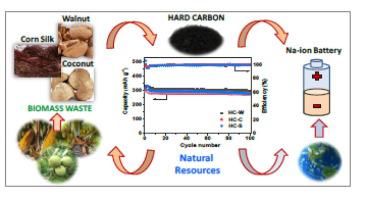Journal of Energy Chemistry ( IF 13.1 ) Pub Date : 2020-09-08 , DOI: 10.1016/j.jechem.2020.08.065 Cristina Nita , Biao Zhang , Joseph Dentzer , Camélia Matei Ghimbeu

|
In recent years, hard carbon materials have gained significant interest as anode materials for Na-ion batteries. Biomass waste is considered one of the most interesting, renewable, available, and cost-effective precursor to obtain hard carbon (HC); however, HC properties must be finely tuned to achieve performance comparable to those provided by Li-ion batteries. In this work, three biomass wastes (coconut shells, walnut shells, and corn silk) were evaluated as potential precursors for HC preparation involving a pyrolysis process and subsequent acid washing to remove the inorganic impurities. All obtained materials exhibited low and similar specific surface areas (< 10 m2⋅g-1), but they presented different structures and surface functionalities. The walnut shell HC possessed a lower amount of inorganic impurities and oxygen-based functional groups compared to the coconut shell and corn silk HCs, leading to higher initial coulombic efficiency (iCE). The structural organization was higher in the case of the walnut shell HC, while the corn silk HC revealed a heterogeneous structure combining both highly disordered carbon and localized graphitized domains. All HCs delivered high initial reversible capacities between 293 and 315 mAh g-1 at 50 mA g-1 current rate, which remained rather stable during long-term cycling. The best capacity (293 mAh g-1 after 100 charge/discharge cycles) and highest capacity retention (93%) was achieved in walnut HCs in half-cells, which could be associated with its higher sp2 C content, better organized structure, and fewer impurities. An “adsorption-insertion” Na storage mechanism is suggested based on several techniques. The walnut HCs exhibited an attractive energy density of 279 Wh/kg when tested in full cells.
中文翻译:

来自椰子壳,核桃壳和玉米丝生物质废物的硬碳,对纳离子电池具有高容量
近年来,硬碳材料作为钠离子电池的负极材料引起了广泛的兴趣。生物质废物被认为是获得硬碳(HC)的最有趣,可再生,可用和具有成本效益的前体之一;但是,必须对HC特性进行微调,以实现与锂离子电池所提供的性能相当的性能。在这项工作中,对三种生物质废物(椰子壳,核桃壳和玉米丝)进行了评估,将其作为潜在的HC制备前体,包括热解过程和随后的酸洗,以去除无机杂质。所有获得的材料表现出低的和类似的比表面积(<10米2 ⋅g -1),但它们呈现出不同的结构和表面功能。与椰子壳和玉米丝HC相比,核桃壳HC具有较少量的无机杂质和基于氧的官能团,从而导致较高的初始库仑效率(iCE)。在核桃壳HC的情况下,结构组织较高,而玉米丝HC则显示出结合了高度无序的碳域和局部石墨化域的异质结构。所有HC均以50 mA g -1的电流速率提供293至315 mAh g -1之间的高初始可逆容量,在长期循环中保持相当稳定。最佳容量(293 mAh g -1在100个充电/放电循环后)和半电池核桃HC中实现了最高的容量保持率(93%),这可能与其较高的sp 2 C含量,更好的组织结构和更少的杂质有关。基于几种技术,提出了一种“吸附插入” Na存储机制。在全电池中测试时,胡桃HC的能量密度为279 Wh / kg。


























 京公网安备 11010802027423号
京公网安备 11010802027423号